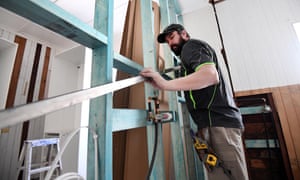The $688m homebuilder scheme has been labelled ‘a gross waste of taxpayer money’
The Institute of Public Affairs has joined economists and backbench MPs in expressing concern about the $688m homebuilder package.
The rightwing thinktank has labelled the $25,000 subsidy for new home builds and substantial renovations “a gross waste of taxpayer money”, as economists warn the payment will line the pockets of homeowners who have already obtained approvals and finance.
The comments follow concerns expressed at the Coalition’s backbench economics committee on Wednesday evening and a regular town hall phone hook-up with Scott Morrison on Thursday.
The concerns ranged from MPs nervous about the amount spent on
stimulus, to Nationals and regional Liberals who argue the $150,000
minimum spend for renovations will put the subsidy beyond the reach of
homeowners outside the capital cities.The rightwing thinktank has labelled the $25,000 subsidy for new home builds and substantial renovations “a gross waste of taxpayer money”, as economists warn the payment will line the pockets of homeowners who have already obtained approvals and finance.
The comments follow concerns expressed at the Coalition’s backbench economics committee on Wednesday evening and a regular town hall phone hook-up with Scott Morrison on Thursday.
The IPA’s director of policy, Gideon Rozner, said the homebuilder policy was “a bank stimulus package by another name”.
“So in order to access this Australians are going to be putting more money on their mortgage, and will end up paying the free $25,000 in interest payments.”
Rozner called on the Morrison government to stop “wasteful stimulus measures”, arguing “we should not be putting home renovations on the national credit card”.
The Nationals senator Matt Canavan and MP Barnaby Joyce both criticised the growing levels of public debt, expected to reach 26% of GDP in the next six months, well below comparable developed countries.
“I completely get what the government is trying to achieve but I am very concerned about where our public debt levels are heading and where our private debt levels are already at,” Canavan told the Australian.
Joyce reportedly said: “I understand how Keynesian stimulus packages work, but the government doesn’t have money. Taxpayers have money. You’ve got to pay it back.
“We’ve got a very high private debt and our redeeming feature has been our low public debt … I’m concerned about the complexity of trying to pay back that debt.”
Despite the Coalition unrest, Scott Morrison insisted the policy is not negotiable; opponents of the scheme are now arguing internally for the assistant treasurer, Michael Sukkar, to guarantee it won’t be extended beyond December.
On Thursday evening, Morrison told A Current Affair that although “none” of the families in the suburbs he knew had $150,000 spare for renovations they “borrow the money to do those renovations” to provide room for growing families.
Morrison said the program was estimated to be spent on 20,000 new home starts and 7,000 renovations and was necessary because of an anticipated drop-off in new home starts in the second half of the year.
The Housing Industry Association estimates at least 14,000 renovations costing over $150,000 are undertaken every year.
Brendan Coates, household finances program director at the Grattan Institute, said given the expected downturn, restoring construction to its normal levels “doesn’t necessarily mean a failure”.
But he said about 110,000 homes are built a year, of which 75,000 would be eligible for grants because they cost $750,000 or less (with land). “It does suggest if there are 20,000 grants for new builds, not many houses wouldn’t otherwise have been built without the scheme.”
Coates said it was “pretty clear” the 7,000 renovations expected to receive a subsidy are “not additional” because only those ready to build could fit the strict June to December timeframe to sign a contract. He cited the lead time to get plans drawn up, costed, engineering, building approvals and finance.
However, the policy could help purchase new homes on the urban fringe on greenfields lots with a “simpler” process to build from scratch.
“If there is a big problem with housing construction, I doubt this scheme will be large enough to fill the gap.
“In terms of bang for its buck – it’s not the best way to go. Social housing would be a better stimulus per dollar spent, particularly compared with the renovation component [of homebuilder].”
The St Vincent de Paul Society chief executive, Toby oConnor, said the government “can do better … it can boost economic activity in the building sector and address the chronic shortage of social housing at the same time”.
“There’s an estimated shortfall of at least 438,000 dwellings and that’s before the anticipated Covid-19 recession fully hits and unemployment peaks in the next few months.”

No comments:
Post a Comment